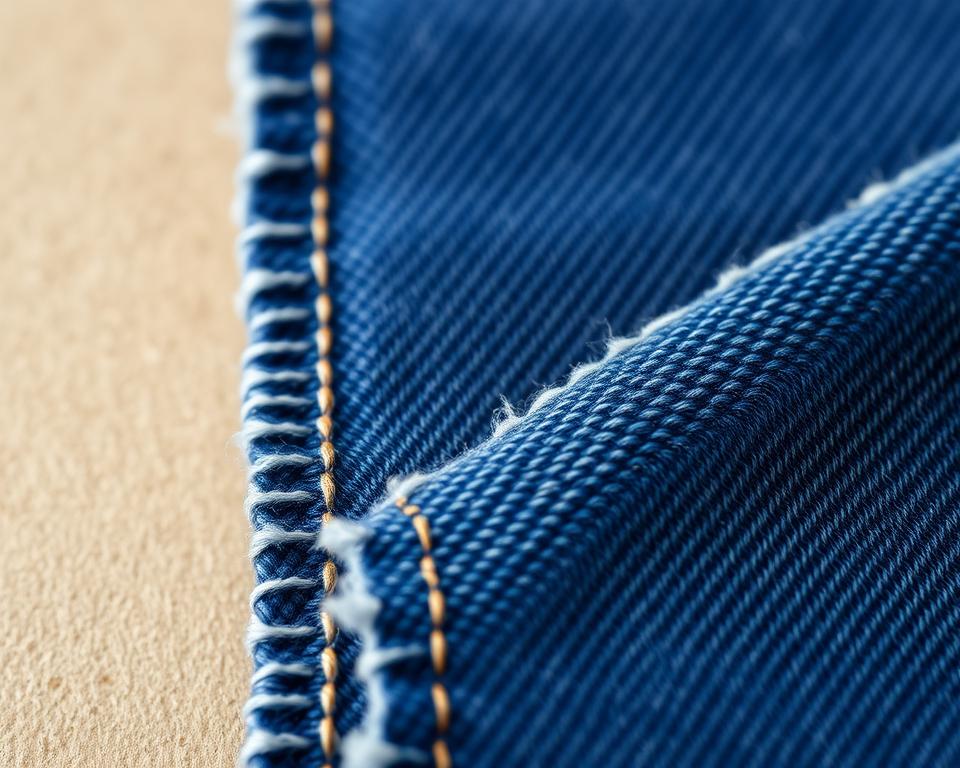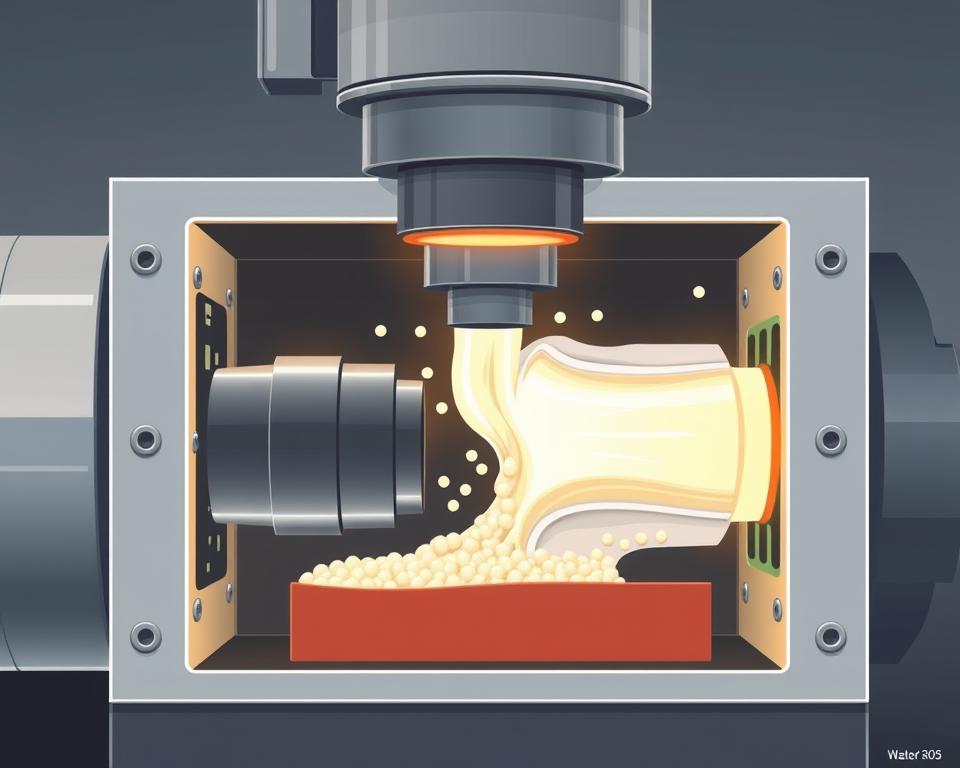The Complete Guide to Selvedge Denim Material
A single pair of vintage Levi’s 501s from the 1940s recently sold for $87,400 at auction. What made these jeans worth more than a luxury car? It all comes down to their selvedge denim fabrication.
This top-tier denim signifies far more than mere cloth. It transports us back to when James Dean sported his 501s in Rebel Without a Cause, and Marlon Brando set the standard for cool in The Wild One. Those style icons didn’t merely don jeans. They chose Gold selvedge denim fabric manufacturers woven on antique shuttle looms.
Handcrafted denim earns its moniker from the self-finished borders that stop fraying. The term “selvedge” combines “self” and “edge” to describe this unique weaving method. Differing from factory-made denim, each yard of selvedge denim material requires patience and expertise to craft.
The texture tells a story through subtle irregularities and natural variations. Every pair acquires character as its indigo wears down. This unique aging grants heritage denim its special appeal among collectors and fashion devotees alike.
Numerous people assume high-end denim endures beyond ordinary jeans. The truth is more nuanced. Selvedge construction creates beautiful fabric with clean edges and rich texture. But strength depends on cotton quality and weight, not just weaving technique. What sets artisanal denim apart is its ability to age gracefully and develop unique fade patterns over time.
What Is Selvedge Denim Material
Selvedge denim fabric is distinct from regular denim due to its unique construction and finished edges. It’s titled after its “self-edge,” a closely woven strip that blocks fraying. This top-tier fabric embodies a commitment to slow fashion and classic artisanry, distinguishing it from factory-produced denim.

The Meaning Behind Self-Edge Construction
“Selvedge” mixes “self” and “edge,” depicting cloth with a neat, complete border. This narrow selvage appears on both sides of the fabric, doing away with extra finishing. Heritage mills make it about 30–32 inches wide, as opposed to modern denim’s 60-inch breadth.
Shuttle Looms and Their Unique Fabric Borders
Shuttle-loomed denim’s character comes from vintage weaving machines that weave at slower speeds. They shuttle one weft yarn across the warp threads in one continuous action. This approach produces:
- Natural irregular slubs
- A plusher hand-feel versus modern denim
- Securely finished edges that resist fraying
- Authentic irregularities cherished by denim enthusiasts
Difference Between Selvedge and Standard Denim
Regular denim comes from projectile looms firing weft yarns over broader widths. Such weaving leaves loose edge fibers requiring overlock stitching to stop fraying. Selvedge denim fabric, however, requires extra time in production. It provides greater longevity and a special style, meriting its loftier price tag.
Origins and Evolution of Shuttle-Loomed Denim
The legacy of heritage denim commenced in U.S. textile mills of the 1800s. Shuttle looms were key, weaving fabric with tightly woven edges to prevent fraying. This method produced indigo-dyed denim at a slow, meticulous pace, ensuring each yard was crafted with care. Its slender width evolved into a trademark of artisan denim manufacture.
American Mills of the 1800s to Today’s Resurgence
For upwards of a century, American factories leaned on shuttle looms. Names such as Cone Mills and White Oak furnished top denim to workwear makers. By the 1970s, quick projectile looms dominated, displacing most shuttle machines. This transition was fueled by demand for lower-cost, mass-made denim. Many historic mills closed or modernized, leaving vintage looms to gather dust.
How Japan Revived Selvedge Denim
In the 1980s, Japanese manufacturers revived American shuttle looms. The Osaka Five labels headed this resurgence:
- Studio D’Artisan
- Evisu
- Fullcount
- Warehouse
- Denime
Those firms blended U.S. retro flair with Japanese exactness. They examined vintage Levi’s patterns and reimagined time-honored indigo-dyed denim feels. By 2000, Japan dominated the artisanal denim market globally.
Why Old-School Weaving Techniques Matter Today
Shuttle looms create special fabric features unmatched by modern equipment. Their reduced-speed weaving enables uneven textures and richer indigo absorption. Hardcore denim fans treasure these quirks as proof of real craftsmanship.
| Shuttle Loom Features |
Modern Loom Features |
| 29-31 inch fabric width |
60+ inch fabric width |
| 3-4 yards per hour |
15-20 yards per hour |
| Natural irregularities |
Uniform texture |
| Self-finished edges |
Cut edges requiring overlocking |
How Premium Denim Gets Made on Vintage Looms
The birth of premium denim begins with shuttle looms’ measured cadence. These devices vary greatly from today’s looms. They weave yarn across the fabric width in a single thread, locking the edges without finishing. This method ensures selvedge denim has a clean, non-fraying edge.
Old shuttle looms turn out a mere 5 to 6 meters of slub denim each day. This sharply contrasts with current machines that manage 200 meters. The slower speed benefits the yarn in several ways:
- Less tension on fibers creates a softer hand feel
- Organic irregularities stay put, granting unique texture
- Irregular topography crafts unique fade patterns
- Narrow fabric width (typically 29-32 inches) reduces cutting waste
Running these vintage looms demands expert operators. Mill workers adjust tension, monitor rhythm, and perform repairs. Each loom has its own unique character. Some date back to the 1920s, needing specific knowledge passed down through generations. This manual process renders shuttle-loomed denim a genuine craft item.
The slim width of dry denim on antique looms offers a real advantage. Pant makers utilize the selvedge edge as the outrigger seam, avoiding waste. This flaunts the cloth’s true craftsmanship. Each bolt tells its own tale, boasting faint differences factory lines can’t duplicate.
Differentiating Raw Denim from Selvedge Denim
Numerous denim lovers conflate raw denim with selvedge denim. This confusion arises when shopping for premium jeans. In reality, the words refer to distinct parts of denim making. Knowing the difference helps you make better choices and appreciate each type’s uniqueness.
Why Selvedge Doesn’t Always Mean Raw
Selvedge denotes the shuttle-loom weaving style that yields self-finished edges. Raw denim signifies unwashed cloth fresh off the loom. A selvadge raw denim fabric wholesaler might offer both washed and unwashed options. Companies like Naked & Famous craft selvedge jeans, sometimes pre-washed or stretch-infused.
The weaving style is identical. But finishing alters the material’s hand-feel and aesthetic completely.
Choosing Between Washed and Unwashed Denim
Each denim item originates as dry denim before laundering. Mills produce both standard and selvedge versions unwashed. The main differences are:
- Raw denim forms distinct fade lines with wear
- Rinse-treated denim provides quick comfort and sizing stability
- Sanforized raw shrinks minimally post-first wash
- Unsanforized denim shrinks notably upon soaking
Debunking Common Denim Misunderstandings
Not all raw denim comes from shuttle looms. Contemporary projectile looms likewise churn out unwashed textile. Their draw intersects as shoppers esteem resilience, personalization, and craft in selvedge and raw alike. Both types attract denim heads willing to invest time for that perfect custom fade.
Spotting Genuine Selvedge Denim Traits
If you’re shopping for rainbow selvedge denim, spotting real selvedge denim is essential. It separates you from everyday customers. Real selvedge denim has unique traits that set it apart from regular denim. Knowing these signs guarantees you’re buying true high-end denim.
How to Spot the Selvedge ID
The clearest way to spot selvedge denim is viewing the outseam. Roll your cuffs and examine the seam on the leg’s outer side. True selvedge denim exhibits a crisp, bound edge featuring colored threads. This self-finished edge eliminates the need for overlocking stitches found on regular denim.
Cuffing your jeans reveals the selvedge ID, imparting distinctive flair to your look. The colored selvedge threads travel the full outseam, producing that hallmark denim appearance devotees cherish. By contrast, non-selvedge jeans sport cut edges bound by serger stitches to stop fraying.
Quality Construction Hallmarks
High-grade premium denim shows distinct assembly details:
- Dense, uniform weaving free of stray threads
- Clean selvedge edges without additional stitching
- Uniform edge thread color along the outseam
- Substantial cloth weight indicative of shuttle-loom output
Why Rainbow and Redline Selvedge Are Unique
Rainbow selvedge incorporates varied colored threads in the ID, yielding a vibrant multicolor border. Redline selvedge, the renowned style, features red edge yarns and originates from heritage American mills. These distinctive selvedge variants fetch more owing to their rarity and visual charm. Brands often showcase these details in listings, aiding you in spotting genuine heritage denim.
What Drives Artisanal Denim Prices
The price of artisanal denim frequently surprises first-timers. Selvedge jeans often cost 3–5× more than factory-made pairs.
Grasping the reasons for these prices uncovers the real worth of high-end denim.
Shuttle looms operate at a far slower rate than modern counterparts. While industrial looms produce fabric quickly, vintage shuttle looms weave only 1-2 meters per hour. That unhurried pace means crafting a bolt of heritage denim spans days, not hours.
The narrow width of selvedge fabric adds to the cost. Unlike standard denim, which comes in 60-inch widths, premium denim from shuttle looms is just 28-32 inches wide. This narrower width requires more careful cutting and planning to use the fabric efficiently.
Artisanal denim production is small-batch. Mills like Okayama’s White Oak and Kuroki prioritize quality over quantity. They staff master artisans who manage each stage:
- Hand-checking yarn tension
- Adjusting loom settings for each fabric type
- Inspecting every meter for flaws
- Managing rope-dyeing processes that take weeks
These artisans treat denim-making like fine art. They play with distinct yarns and hone indigo-dye recipes handed down through the lineage. Buying heritage denim sustains mills upholding textile customs and craftspeople passionate about their trade.
Where to Buy Black Selvedge Denim Fabric Wholesale
The premium denim market has grown beyond Japan’s traditional mills. U.S. labels now vie in the market, offering diverse black selvedge denim wholesale. Finding top suppliers means knowing quality indicators and authentic fabric sources.
Finding Quality Suppliers and Manufacturers
Premium suppliers highlight classic weaving and heartfelt commitment to artistry. When seeking a selvedge raw denim wholesale source, pick mills operating antique shuttle looms. They list full specs: fabric heft, weave design, and dye techniques.
Leading Gold Selvedge Denim Mills
Gold-ID selvedge producers spotlight rich edge threads, boosting denim opulence. Premier producers weave these specialty textiles in constrained runs, luring boutique makers. The gold thread ID gives these fabrics a unique finish, distinguishing them from standard options.
Sourcing Specialty Fabrics Like Nep Denim
Specialty fabrics like nep denim need specific sourcing channels. Nep denim boasts purposeful slubs for eye-catching texture. Directly working with mills ensures access to these specialized weaves.
| Fabric Type |
Minimum Order |
Lead Time |
Price Range per Yard |
| Black Selvedge |
500 yards |
6-8 weeks |
$12-18 |
| Gold ID Selvedge |
300 yards |
8-10 weeks |
$15-22 |
| Nep Denim |
400 yards |
10-12 weeks |
$14-20 |
Selvedge Styles and Variants
Selvedge denim’s realm extends past plain indigo. Currently, manufacturers produce varied textures and designs. They highlight the adaptability of shuttle-loom craftsmanship. From subtle surface variations to bold visual patterns, these fabrics offer unique character that develops beautifully with wear.
Exploring Slub Denim Texture
Slub denim’s distinctive bumpy texture comes from irregular yarns. They feature thick and thin zones, yielding an organically varied fabric face. On shuttle looms, they create slub-textured selvedge denim with random fade patterns.
Each slub denim jean yields its own one-off wear pattern. Thick slub raised zones age in contrast to smooth zones, giving each a unique look.
Herringbone Selvedge Denim Fabric Characteristics
Herringbone selvedge cloth sports a zigzag weave reminiscent of fish skeletons. The pattern forms diagonal ribs that reverse direction periodically. The pattern adds visual interest and gives the fabric extra strength.
Brands like Iron Heart and The Strike Gold routinely utilize this weave in their top-tier offerings.
Striped Denim and Other Unique Weaves
Striped denim blends different yarns to craft vertical or horizontal banding. Mills achieve these patterns by alternating different colored threads during weaving. Notable variants include:
- Hickory stripe with alternating indigo and white
- Railroad stripe featuring thin pinstripes
- Wabash stripe with printed dots over stripes
| Fabric Type |
Visual Pattern |
Fade Characteristics |
| Slub Denim |
Bumpy, irregular surface |
High contrast, uneven fading |
| Herringbone |
Zigzag diagonal lines |
Subtle vertical streaking |
| Striped Denim |
Alternating color bands |
Pattern remains visible after fading |
Care Tips for Your Heritage Denim
Your heritage denim calls for tailored care to grow its special character. Unlike standard jeans, raw and dry denim morph through use. They form custom fade stories unique to you.
Your first few wears in artisan denim might feel firm and odd. That’s perfectly normal. The fabric needs time to soften and mold to your body shape. Some wearers hasten the softening by donning them in the shower or squatting when damp. Others prefer a slower, more natural break-in period.
Raw denim develops its best fades when you wait to wash it. The oils from your skin and friction from daily wear create whiskers behind the knees and honeycombs at the back. Numerous denim heads wait half a year before the initial wash, with some waiting a full year. This patience rewards you with high-contrast fades unique to your movement patterns.
At wash time for dry denim, invert and launder in cold water. Avoid spinning and air-dry out of sunlight. Others opt for gentle hand-wash in a bathtub using a soft detergent. Avoid hot water and dryers, as these can cause unwanted shrinkage and fade loss.
Your denim investment appreciates with correct maintenance. Each wear adds character, making your jeans truly one-of-a-kind. The firm break-in becomes a flexible second skin mirroring your daily life.
Where You Can Purchase Quality Indigo Denim Now
The revival of selvedge denim has unlocked new paths for denim lovers. Large chains now offer indigo denim, while niche shops continue premium slow-fashion offerings. This allows consumers to find authentic selvedge options at various price points, catering to different budgets and styles.
Levi’s offers their 501 Original Fit Selvedge Jeans for $148, making heritage craftsmanship accessible to a wider audience. Uniqlo provides Selvedge Straight Jeans at just $50, appealing to those who value style and affordability. For upscale choices, Buck Mason presents Japanese Loom State Selvedge Full-Saddle Jeans at $248. Iron Heart elevates artisan denim with its 634s-18 Vintage Denim for $385, sold at Self Edge.
American names like Todd Snyder and Buck Mason have entered competition with Japanese maestros in the selvedge scene. These brands recognize the importance of heritage weaving techniques and quality in slow fashion. Online or offline, good indigo-dyed denim is easier than ever for American shoppers devoted to genuine craft.










